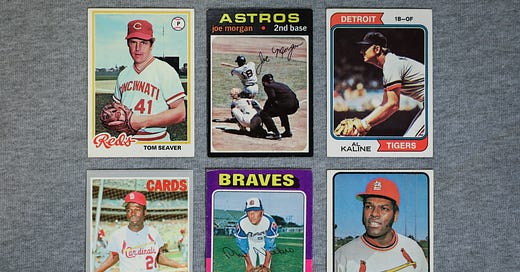One of your key responsibilities is to not only develop your team but also to advocate for them within the organization. A simple, effective tool to help with this is the Baseball Card — a concise, one-page document designed to quickly share the successes and key details of each team member.
I love using this tool. As you’ll see, it started out as a crisis tool, but I eventually adapted it to be a useful tool in all aspects of managing a team.
I call it a baseball card because of the concept of key information and key stats – not because it is an actual card. It just helps to keep the information limited to ensure the highlights are not lost.
The Crisis
I was managing a team for a company that had recently been purchased by a larger company. As is usually the case because of all the legal aspects of a purchase, we knew that the larger company was going to own us several months before the sale went through. As you can imagine, there was a lot of concern about what would happen to the company and individuals once the sale was finalized.
With this much uncertainty, I worked with my team to not only keep them focused on what we needed to accomplish, but also to prepare them for any upcoming disruptions. I knew that layoffs and terminations were possible (the dreaded duplication of effort issue), but I had little real information to help my team.
I decided to do my best to promote the value of the team and every individual to the new owners. The only thing I could do was show how keeping us on would be a benefit, so that was my plan. That is where I started using the baseball card idea. I had everyone put together a 1-page document that gave key information about them, their skills, their accomplishments, and their future aspirations. I kept these and every time I met with someone from the new organization, I used those documents as reference to advocate for my team.
The result? When the sale went through, the new organization started to terminate people because of redundancy. Every department lost at least one person, some departments were completely eliminated.
Except mine – not one person on my team was let go. In fact, the CEO of the new organization told me that learning about the great work our team was doing was a pleasant surprise and an added benefit to the deal that they hadn’t anticipated.
What to Include on a Baseball Card
You can adapt the things you put on the card, the key is to ensure it is limited to one-side of an 8.5” X 11” piece of paper. Here is what I have my employees list
Basics: Name, title, and length of time with the company.
Credentials: Degrees, certificates, or relevant courses completed.
Role Overview: A brief description of their main responsibilities.
Successes: Highlight key achievements, ideally with measurable metrics.
Current Projects: What are they working on right now?
Skill Development: Areas they are actively developing and have recently developed.
How to Use It Effectively
Start as an Exercise. Have team members draft their own Baseball Cards. This encourages self-reflection and ownership of their growth. It also creates clarity because as you review them, you can ask questions or make suggestions.
Keep It Concise. Limit it to one page. If new information is added, prioritize what's most relevant and impactful.
Use these as you advocate for your team throughout the company. Take the accomplishments and skill development and share it as much as possible. Don’t send the actual baseball card, but mention key details to others that might be important. This is how you advocate for your team in the rooms where they may not be present.
Maintain a Brag Book. Don’t discard removed details. Move them to a separate file — the “Brag Book” — to keep a comprehensive record of past achievements. The Brag Book is a total of all the skills and accomplishments over a lifetime. This comes in handy during performance reviews or when seeking a new role or opportunity. If a certain role calls for a specific skill, you can find it in your brag book with all the key information needed to communicate it effectively.
Regular Updates. While updating every six months is common, monthly updates ensure nothing significant gets overlooked.
The Payoff:
The Baseball Card helps you advocate effectively for your team. It provides a quick snapshot of who they are, what they’ve accomplished, and where they’re headed. It’s a career-long habit worth adopting, both for you and your team.





